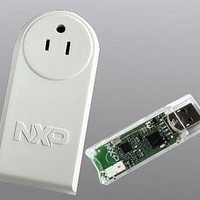OM13005,598 NXP Semiconductors, OM13005,598 Datasheet - Page 202

OM13005,598
Manufacturer Part Number
OM13005,598
Description
BOARD EVAL EM773 METER US PLUG
Manufacturer
NXP Semiconductors
Type
Other Power Managementr
Specifications of OM13005,598
Design Resources
Plug Meter Schematics, Gerber Files USB Dongle Schematics, Gerber Files
Main Purpose
Power Management, Energy/Power Meter
Embedded
Yes, MCU, 32-Bit
Utilized Ic / Part
EM773FHN33,551
Interface Type
USB
Maximum Operating Temperature
+ 150 C
Operating Supply Voltage
1.8 V to 3.6 V
Product
Power Management Development Tools
Lead Free Status / RoHS Status
Lead free / RoHS Compliant
Primary Attributes
-
Secondary Attributes
-
Lead Free Status / Rohs Status
Lead free / RoHS Compliant
For Use With/related Products
EM773, OL2381
Other names
568-6680
- Current page: 202 of 310
- Download datasheet (6Mb)
NXP Semiconductors
UM10415
User manual
18.2.3 Criterion for Valid User Code
Criterion for valid user code: The reserved Cortex-M0 exception vector location 7 (offset
0x 0000 001C in the vector table) should contain the 2’s complement of the check-sum of
table entries 0 through 6. This causes the checksum of the first 8 table entries to be 0. The
boot loader code checksums the first 8 locations in sector 0 of the flash. If the result is 0,
then execution control is transferred to the user code.
If the signature is not valid, the auto-baud routine synchronizes with the host via serial port
0. The host should send a ‘?’ (0x3F) as a synchronization character and wait for a
response. The host side serial port settings should be 8 data bits, 1 stop bit and no parity.
The auto-baud routine measures the bit time of the received synchronization character in
terms of its own frequency and programs the baud rate generator of the serial port. It also
sends an ASCII string ("Synchronized<CR><LF>") to the Host. In response to this host
should send the same string ("Synchronized<CR><LF>"). The auto-baud routine looks at
the received characters to verify synchronization. If synchronization is verified then
"OK<CR><LF>" string is sent to the host. Host should respond by sending the crystal
frequency (in kHz) at which the part is running. For example, if the part is running at
10 MHz, the response from the host should be "10000<CR><LF>". "OK<CR><LF>" string
is sent to the host after receiving the crystal frequency. If synchronization is not verified
then the auto-baud routine waits again for a synchronization character. For auto-baud to
work correctly in case of user invoked ISP, the CCLK frequency should be greater than or
equal to 10 MHz.
Once the crystal frequency is received the part is initialized and the ISP command handler
is invoked. For safety reasons an "Unlock" command is required before executing the
commands resulting in flash erase/write operations and the "Go" command. The rest of
the commands can be executed without the unlock command. The Unlock command is
required to be executed once per ISP session. The Unlock command is explained in
Section 18.4 “UART ISP commands” on page
All information provided in this document is subject to legal disclaimers.
Rev. 1 — 10 September 2010
Chapter 18: EM773 Flash memory programming firmware
208.
UM10415
© NXP B.V. 2010. All rights reserved.
202 of 310
Related parts for OM13005,598
Image
Part Number
Description
Manufacturer
Datasheet
Request
R
Part Number:
Description:
NXP Semiconductors designed the LPC2420/2460 microcontroller around a 16-bit/32-bitARM7TDMI-S CPU core with real-time debug interfaces that include both JTAG andembedded trace
Manufacturer:
NXP Semiconductors
Datasheet:

Part Number:
Description:
NXP Semiconductors designed the LPC2458 microcontroller around a 16-bit/32-bitARM7TDMI-S CPU core with real-time debug interfaces that include both JTAG andembedded trace
Manufacturer:
NXP Semiconductors
Datasheet:
Part Number:
Description:
NXP Semiconductors designed the LPC2468 microcontroller around a 16-bit/32-bitARM7TDMI-S CPU core with real-time debug interfaces that include both JTAG andembedded trace
Manufacturer:
NXP Semiconductors
Datasheet:
Part Number:
Description:
NXP Semiconductors designed the LPC2470 microcontroller, powered by theARM7TDMI-S core, to be a highly integrated microcontroller for a wide range ofapplications that require advanced communications and high quality graphic displays
Manufacturer:
NXP Semiconductors
Datasheet:
Part Number:
Description:
NXP Semiconductors designed the LPC2478 microcontroller, powered by theARM7TDMI-S core, to be a highly integrated microcontroller for a wide range ofapplications that require advanced communications and high quality graphic displays
Manufacturer:
NXP Semiconductors
Datasheet:
Part Number:
Description:
The Philips Semiconductors XA (eXtended Architecture) family of 16-bit single-chip microcontrollers is powerful enough to easily handle the requirements of high performance embedded applications, yet inexpensive enough to compete in the market for hi
Manufacturer:
NXP Semiconductors
Datasheet:

Part Number:
Description:
The Philips Semiconductors XA (eXtended Architecture) family of 16-bit single-chip microcontrollers is powerful enough to easily handle the requirements of high performance embedded applications, yet inexpensive enough to compete in the market for hi
Manufacturer:
NXP Semiconductors
Datasheet:
Part Number:
Description:
The XA-S3 device is a member of Philips Semiconductors? XA(eXtended Architecture) family of high performance 16-bitsingle-chip microcontrollers
Manufacturer:
NXP Semiconductors
Datasheet:

Part Number:
Description:
The NXP BlueStreak LH75401/LH75411 family consists of two low-cost 16/32-bit System-on-Chip (SoC) devices
Manufacturer:
NXP Semiconductors
Datasheet:

Part Number:
Description:
The NXP LPC3130/3131 combine an 180 MHz ARM926EJ-S CPU core, high-speed USB2
Manufacturer:
NXP Semiconductors
Datasheet:

Part Number:
Description:
The NXP LPC3141 combine a 270 MHz ARM926EJ-S CPU core, High-speed USB 2
Manufacturer:
NXP Semiconductors

Part Number:
Description:
The NXP LPC3143 combine a 270 MHz ARM926EJ-S CPU core, High-speed USB 2
Manufacturer:
NXP Semiconductors

Part Number:
Description:
The NXP LPC3152 combines an 180 MHz ARM926EJ-S CPU core, High-speed USB 2
Manufacturer:
NXP Semiconductors

Part Number:
Description:
The NXP LPC3154 combines an 180 MHz ARM926EJ-S CPU core, High-speed USB 2
Manufacturer:
NXP Semiconductors

Part Number:
Description:
Standard level N-channel enhancement mode Field-Effect Transistor (FET) in a plastic package using NXP High-Performance Automotive (HPA) TrenchMOS technology
Manufacturer:
NXP Semiconductors
Datasheet:










